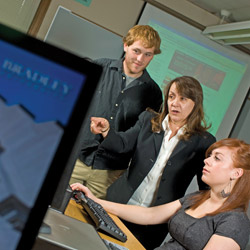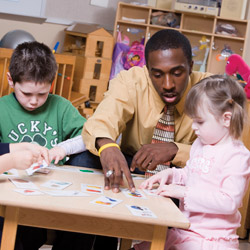
President Obama and U.S. Secretary of Education Arne Duncan are calling for “revolutionary change” in our educational system with incentive grants such as Race to the Top funding opportunities for states to facilitate change. Preparing our young people is a moral and economic imperative.
National Lessons for Transforming Educational Systems
Students today must compete in a global economy; a strong educational system is the foundation and prerequisite to their success. Accessible education is a civil rights issue for all children to be able to enter the world of work and become educated citizens to support our democracy.
In March of 2010, the U.S. Department of Education published A Blueprint for Reform, outlining five areas of focus:
- College- and career-ready students
- Great teachers and leaders in every school
- Equity and opportunity for all students
- Raise the bar and reward excellence
- Promote innovation and continuous improvement.
Through the mid-20th century, the United States was considered a global leader in education. By the end of the 20th century and into the 21st century, the United States progressively lost ground in the areas of math, reading, science and problem solving. This trend prompted The Partnership for 21st Century Skills to develop a vision to strengthen American education focused on changes needed for success in a global society:
- Core subjects: English, reading/language arts, mathematics, science, foreign languages, civics, government, economics, arts, history and geography
- Learning skills in information and communication, thinking and problem solving, and interpersonal and self-directional
- Tools for using information and communication technologies to access, manage, integrate and evaluate information; construct new knowledge; and communicate with others effectively and ethically
- Context learning through real-world examples, applications and experiences in the process of using 21st-century tools
- Content that integrates global awareness; financial, economic and business literacy; and civic literacy
- Balanced assessments (high-quality standardized testing and classroom assessments) for improved teaching and learning.
Challenging this vision are major issues related to our teaching force in the U.S. Currently, there are 3.2 million teachers, and one third will retire in the next four to five years. Teaching positions in science, technology, mathematics and special education are already difficult to fill. Producing great teachers and school leaders is key to establishing community partnerships for success in educating our nation’s children, including those in central Illinois. Today’s children will be central Illinois’ economic drivers tomorrow. What We Have Learned Internationally
What We Have Learned Internationally
Hargreaves and Shirley, in The Fourth Way: The Inspiring Future for Educational Change, provide insightful information about top-performing students and their educational communities around the world. They analyzed the performance of elementary and secondary students in academics based on national and international tests, particularly in reading, language arts and literacy, mathematics, and the sciences.
The top-performing nation was Finland. Finnish children have consistently scored first or second internationally on the Organization for Economic Cooperation & Development Programme for International Student Assessment, comparing student performance of 15-year-olds in the aforementioned disciplines. Finland is also a high performer in economic competitiveness and corporate transparency.
Also analyzed were top educational networks and “turnaround districts” around the world. One of the top innovative and effective networks cited was the Raising Achievement, Transforming Learning network of 300 secondary schools in the United Kingdom, with impressive student achievement results. Two thirds of these schools improved at double the rate of secondary schools not in the network. Rather than top down, change is driven by lateral support heightened by professional engagement, inquiry and reflection by teachers and principals. Turnaround districts in inner cities were cited around the world. Many offered “wraparound services” similar to the “full-service community schools” movement in the U.S., providing health services, agency support and education for children and families at school sites. One impressive turnaround district cited was Tower Hamlets in London, England. Proclaimed the country’s worst-performing district in 1997, they now score above the national average, with the highest rates of students prepared for college.
Commonalities were cited among these high-performing educational systems:
Aligning vision and practice:
- a compelling vision
- learning priorities attached to vision
- evidence-informed improvement.
Steering professional practice:
- attraction and retention of high-quality teachers
- professional empowerment and cultures of trust
- professional networks of peers and mentors.
Collaborating with stakeholders:
- trust between districts and schools
- cultures of improvement (strong help the weak)
- community empowerment.
 Community Collaboration for Transformational Change
Community Collaboration for Transformational Change
Research supports the need for highly qualified teachers, but explicitly indicates that teachers cannot do it alone. Key to systemic change is collaboration among all stakeholders—legislators, universities, schools and communities working toward a common goal of preparing teachers who will be highly qualified to practice in comprehensive 21st-century learning environments.
Such collaboration supports the model for full-service community schools first conceived by Jane Addams in the late 1800s and promoted by educational leaders like Dewey throughout the 20th century. Full-service community schools have the flexibility to comprehensively address the needs of children and families. Extensive research supports educating the whole child—physically, socially and emotionally—as well as providing support for family well-being to strengthen and maintain children’s academic progress.
Additionally, research on Professional Development Schools (PDSs) supports such a collaborative model. The National Council for the Accreditation of Teacher Education defines PDSs as “innovative institutions formed through partnerships between professional education programs and P-12 schools.” The focus is on preparing highly qualified teachers, educational leaders and healthcare professionals through professional development directed at improving practice to enhance student achievement. Research on PDSs indicates there is improved teaching quality and student achievement.
Full-service community schools actively teaming with PDSs provide opportunity for the entrepreneurial vision of stakeholders. Stakeholders focused on a common vision to bring American education into the 21st century by implementing 21st-century skills.
Central Illinois is paying attention and is actively engaged in transformational change in education. Currently, there are schools implementing the full-service community school and PDS models. These collaborations unify the community to provide school-based services in healthcare, agency support, technical training and education to children and families, in addition to creating innovative, real-world 21st-century learning environments. The entrepreneurial spirit is alive within our schools, families and community leaders—success will create more success. These stakeholders are enthusiastic about the changes that are happening and are proposing additional changes to bring our schools into the 21st century. Others have made transformational change, and we can too.
Extending Hargreaves and Shirley’s Fourth Way into central Illinois, we envision 21st-century skills as the foundation of transformational change. At the core is professional practice, supported by a clear vision and an empowered collaboration of stakeholders. The development of economic resiliency and sustainability through full-service community schools will promote global leadership in education. Martin Luther King, Jr. once said, “It’s not just the goals you set for yourself in life that are important, but it is the journey in achieving those goals that makes the difference.” If we take that journey together with our community to transform our educational system, it will make all the difference. iBi
Joan L. Sattler, Ed.D. is dean and professor of education in the College
of Education & Health Sciences at Bradley University. Celia E. Johnson, Ed.D. is a professor in the Department of Teacher Education and coordinator of special education programs in the College of Education & Health Sciences at Bradley University.

